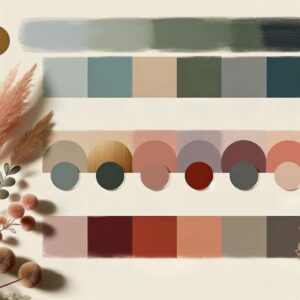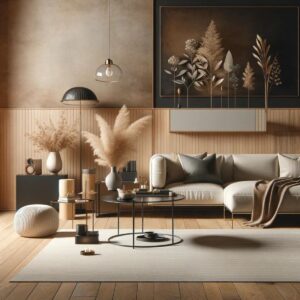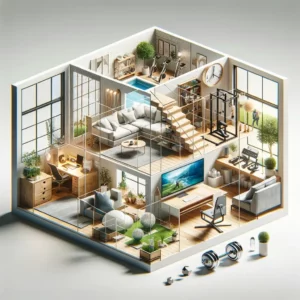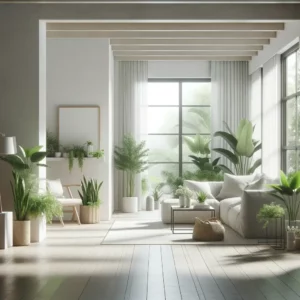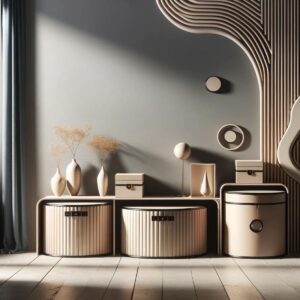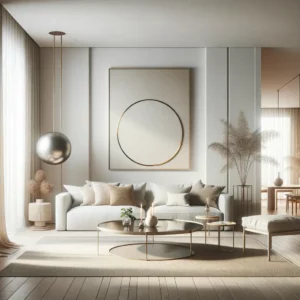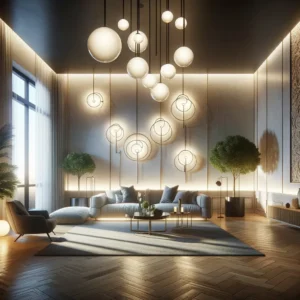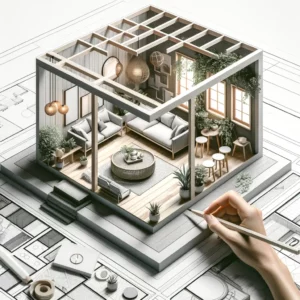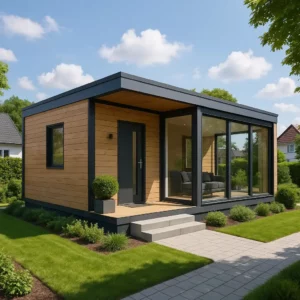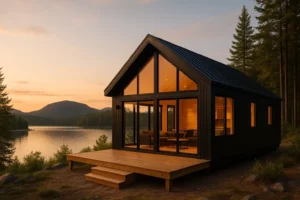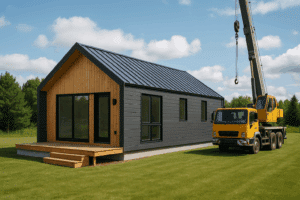By 2026, the interior design of prefabricated homes is being reinvented, prioritizing comfort, sustainability, and personalization. These advancements mark a significant evolution in the sector, where the quality and adaptability of spaces are becoming paramount.
Thus, prefabricated houses are no longer simply an economical alternative, but a sustainable living choice that meets specific needs and individual tastes.
1. Color trend
The color palette for prefabricated home interiors in 2026 is decidedly geared towards softness and calming, favoring shades that invite relaxation and well-being.
Soft colors and earth tones dominate this trend, with a predilection for light blue, symbolizing serenity and space. Soft blacks, far from oppressive, bring elegant depth and subtle contrast to living spaces, while dark greens recall the hues of nature, promoting a sense of renewal and vitality. Shadowy reds, used sparingly, inject warmth and visual richness, creating points of interest and energizing the space without overwhelming it.
This color selection reflects a growing desire to reconnect with natural and soothing elements, while building interior environments where visual and emotional comfort are paramount. The use of these colors in prefabricated homes is not trivial; it is part of a process of creating spaces that are not only functional and sustainable, but also deeply welcoming and relaxing.
The harmony of the selected colors allows us to design interiors where we instantly feel at home, ready to welcome moments of life in complete peace.
To conclude the section on color trends, here's a chart illustrating the modern shades that will dominate in 2026. Each color is accompanied by its HEX code, allowing you to easily find them for your design projects on platforms like Canva. These hues were chosen for their ability to create spaces that are both trendy and relaxing, promoting well-being in every prefabricated home. We hope this sparks your creativity!
2. Understated luxury
The "understated luxury" trend is part of an interior design approach where ostentatious splendor gives way to subtle and measured sophistication. This approach focuses on quality craftsmanship, the use of sustainable materials, and the careful selection of furniture with impeccable finishes. It's no longer quantity that matters, but the authenticity and durability of the chosen objects.
With this in mind, the interior design leans toward noble materials and textures that invite touch, where luxury is felt rather than displayed. Rich, weathered woods, natural fabrics like linen or raw wool, and carefully patinated metals are all elements that create this atmosphere of understated luxury.
Industrial minimalism, with its clean lines and cool surfaces, is giving way to warmer, more welcoming interiors. This translates into an enveloping color palette, organically shaped furniture that encourages conviviality, and soft lighting that highlights the textures and nuances of the space.
This focus on understated luxury is also evident in the attention to detail, which, while discreet, is designed to enhance the daily experience. The meticulous finishes, precise fittings, and personalized design touches add significant value to the living space.
In short, understated luxury in interior design is an invitation to rediscover richness in simplicity, to value quality over quantity, and to design spaces that stand the test of time not only through their durability, but also through their aesthetic timelessness.
3. Intentional or multifunctional space
An intentional space is a living area designed with a specific purpose, reflecting a thoughtful approach to space use that supports the daily activities of residents.
It is a space that combines aesthetics and functionality to meet specific needs of comfort, productivity or leisure, often with the possibility of adapting and transforming for different uses.
In the multifunctional spaces, each element is deliberately chosen and placed to create an environment that promotes well-being and efficiency. This maximizes space by promoting versatility and adaptability, transforming the same room into a place of work, relaxation or creation according to the needs of the moment.
By 2026, the interiors of prefabricated homes are distinguished by their intentional functionality. The spaces, designed to be multi-purpose, easily transform into home offices, gyms, or relaxation areas, reflecting our dynamic lifestyle.
Modular design solutions, such as retractable partitions or convertible furniture, allow you to create adaptive environments while maintaining a refined and harmonious aesthetic.
Moreover, in the face of rising property prices and growing ecological awareness, optimizing living space is becoming a current and sensible response.
It is in this same vein that we find a growing popularity for everything that is minimalism. For example, tiny houses Or mini-cabins.
Finally, in our article on the multifunctional spaces, We've developed a matrix that makes it easier to design and visualize the number of rooms required in your future home. Take a look!
4. Live healthy
Prefabricated homes are largely inspired by biophilic design*, which aims to strengthen the connection between occupants and nature.
Integrating natural elements such as green walls, using organic materials and maximizing natural light transforms the living space into a sanctuary of tranquility.
Outdoor spaces are designed to become living extensions of the home, offering green spaces and places to relax in the fresh air, thus strengthening our connection to the environment.
Innovations in indoor air quality are no exception, with advanced ventilation systems and non-toxic building materials contributing to a healthier home environment.
This awareness and investment in home health is not only a response to contemporary ecological concerns, but also a commitment to a greener, more harmonious and healthier life.
* Biophilic design is the integration of natural elements into indoor environments to strengthen the connection between humans and nature.
5. Decorative storage
Storage is no longer just a functional necessity; it is becoming a key component of interior design, especially in the trends of 2026.
The rise of decorative and personalized storage solutions is transforming our living spaces, combining aesthetics and organization. Storage boxes, far from being simple containers, are adorned with refined patterns and textures, becoming true decorative objects. They help maintain order and clarity, while adding a personal and stylish touch to the environment.
The cabinets adopt curved and fluid shapes, breaking with traditional rigidity to blend harmoniously into the space. These pieces of furniture don't just hide clutter; they enrich the decor, reflecting a careful attention paid to both functionality and beauty.
Thus, decorative storage represents a successful fusion between utility and artistic expression, offering a new dimension to modern interior design.
6. Social spaces
In today's age, where technology often dominates our interactions, the "social spaces" trend marks a welcome return to conviviality and direct communication. This design direction prioritizes seating options that encourage interaction and sharing, with sofas and armchairs designed to bring people together, both literally and figuratively.
The welcoming, contemporary shapes of these seats invite relaxation and openness, creating spaces where conversation flows naturally. Whether through curved sofas encouraging eye contact or armchairs strategically positioned to facilitate dialogue, each piece is designed to stimulate social interaction.
This trend reflects a growing awareness of the central role furniture plays in facilitating human connection. By providing a comfortable and aesthetically pleasing setting, "social spaces" help transform homes into true havens of conviviality, where relationships can flourish away from screens.
7. Minimaluxe
The “Minimaluxe” trend embodies a vision of luxury that is both minimalist and refined, where simplicity blends with elegance to create soothing and luxurious interiors. This design approach favors a clean color palette of soft, neutral tones that invite tranquility and serenity. Textures play a key role, with a penchant for soft, comforting materials that add a subtle tactile dimension without overwhelming the space.
Minimaluxe advocates a sense of lightness and openness, favoring well-arranged, airy spaces that exude tranquility. This pared-down aesthetic highlights carefully selected design elements, allowing a few favorite pieces to stand out as focal points in an otherwise minimalist environment. Whether it's a unique art object, a designer piece of furniture, or a sculptural lighting piece, each element is chosen for its power to evoke simple, timeless beauty.
Thus, “Minimaluxe” reveals a new dimension of luxury, where quality takes precedence over quantity, and where space itself becomes a canvas for moments of life imbued with beauty and serenity.
8. Decorative wall lighting
Decorative wall lighting is emerging as a key element of interior design in 2026, transcending its functional role to become a true work of art. This evolution marks a new era where light sculpts space, playing with volumes and textures to enrich the ambiance of every room.
The selection and placement of wall-mounted lighting fixtures are carefully considered, aiming to illuminate interiors in a way that accentuates architecture and decorative elements, while creating a warm and welcoming atmosphere. Whether to highlight a piece of art, emphasize a wall texture, or simply add an aesthetic dimension to the space, wall lighting comes in a multitude of shapes, materials, and colors.
Designers are exploring innovative designs where lighting not only illuminates but also becomes a focal point of the decor. Decorative wall lighting offers an endless range of possibilities for personalizing your interior. By playing with the intensity and direction of light, it's possible to transform the ambiance of a room, transforming it from a dynamic and stimulating space to a haven of peace and relaxation.
Thus, decorative wall lighting embodies this quest for an interior design that combines beauty and functionality, where light becomes a key element of personal expression and domestic comfort.
9. Interior Design Tips for Prefabricated Homes
Improving your prefabricated home requires smart and creative interior design choices. Here are some enriched and tailored tips to transform your space:
- Play with patterns Don't limit yourself to a single color palette or pattern. Pre-designed interiors offer the freedom to mix and match patterns and prints to diversify the feel of a single room. From printed rugs and cushions to curtains and table runners, use these elements to add a touch of originality to your spaces.
- Incorporate indoor plants Plants aren't just good for air quality; they add life, color, and personality to your home. Depending on your space, opt for potted plants, terrariums, or even vases to bring nature into your home.
- Opt for small paintings Given the space constraints of prefabricated homes, opt for smaller pieces of art. Arranged in groups, they can create the illusion of a larger, more airy space.
- Create sets of similar items : Using sets of similar or complementary decorative items, such as vases or cushions of different sizes, can add depth and character to your decor without overwhelming the space.
- Personalize your space The advantage of prefabricated homes lies in their high customization potential. Create a unique interior by choosing objects and colors that reflect your personality and travels.
- Use negative space : Don't underestimate the power of empty space. By leaving space around your furniture, you create a sense of spaciousness and flow, contributing to a more orderly and spacious aesthetic.
- Avoid overfilling the space : Resist the temptation to overload your decor. Adopt a minimalist approach and consider adding or changing decorative elements gradually to maintain a balanced and open atmosphere.
- Layer the furnishings : In small spaces, layering textiles and decorations can create visual richness without clutter. Mirrors, paintings, rugs, and bedspreads can be used to add layers of decor, amplifying the sense of space and intimacy.
These tips aim to maximize the aesthetic and functional potential of your prefabricated home, making every design choice a way to beautify and optimize your living space.
Towards an Innovative Habitat: Interior Design for Prefabricated Houses
By embracing the principles of interior design for prefabricated homes, we open the door to living spaces that combine aesthetics, functionality and personalization.
These tips aren't just ways to beautify your home; they represent a deeper reflection on how we inhabit our spaces, adapting them to our unique needs and in harmony with the environment.
The future of interior design in the field of prefabricated housing is bright, offering endless possibilities for creating homes that are beautiful, practical, and environmentally friendly.
Let’s embark together on this creative adventure, shaping interiors that resonate with our times and anticipate the needs of tomorrow.
Reference :
- https://www.claytonhomes.com/studio/new-home-design-trends/
- https://www.livingetc.com/whats-news/the-biggest-interior-trends-195539
- https://foyr.com/learn/guide-to-prefabricated-homes-interior-design/

